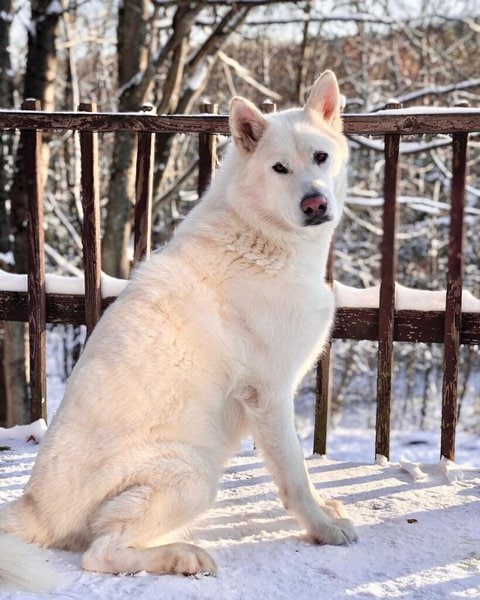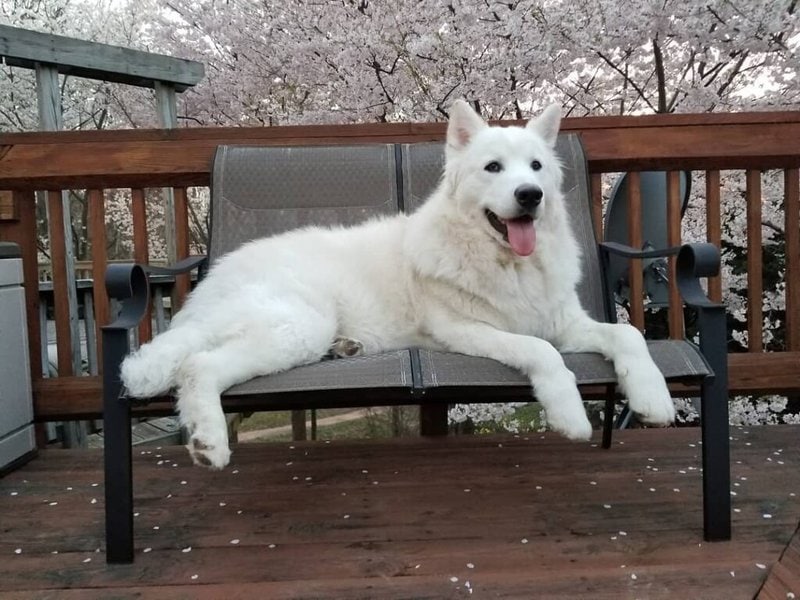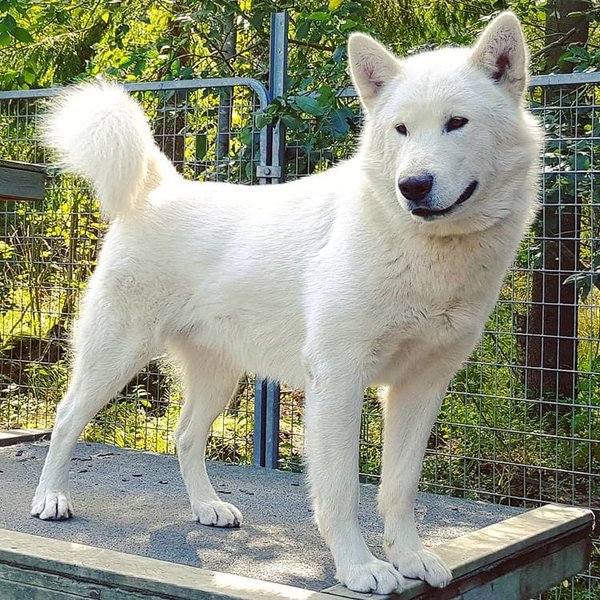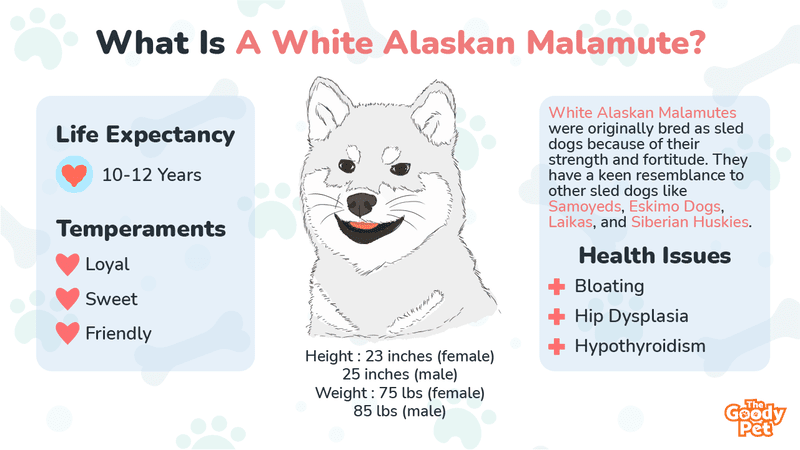As suggested by the name White Alaskan Malamute, this dog was first bred in Alaska, United States, and used to pull heavyweights.
Did you know that apart from reindeer, White Alaskan Malamutes were also used as sled pullers? Yes, the furry White Alaskan Malamutes were originally bred as sled dogs because of their strength and fortitude. They have a keen resemblance to other sled dogs like Samoyeds, Eskimo Dogs, Laikas, and Siberian Huskies.
This canine has a furry plumed tail, big erect ears, fluffy coats, and substantial bones. They are adorable enough to make a good household pet that is well-behaved and friendly. Bred for speed and strength, they are powerful and have well-structured bodies. The White Alaskan Malamute is known for its playful, energetic, and affectionate behavior. Aggression is not a concern, so if you are looking for a furry friend, they will make a perfect companion. Sit back, and we will tell you the right ways to pamper and care for your White Alaskan Malamute.
How Big Do White Alaskan Malamutes Get?

The White Alaskan Malamute is a large dog breed growing as tall as 23 inches for females and 25 inches for males. Their weight ranges from 75 lbs for a female Alaskan Malamute to 85 lbs for its male counterpart.
However, there are some heavier and smaller dogs weighing 90 lbs and 75 lbs each, respectively. There is a significant size difference between females and males. Some Malamutes can weigh 100 lbs.
Physical Appearance
Their undercoat is oily and wooly in texture with a thickness of 2 inches. The outer hairy coat protects from cold climatic conditions. They have small ears that stand erect when they are attentive.
You may relate Malamutes with Huskies, but let us tell you a surprising fact that, unlike Huskies, Alaskan Malamutes cannot have blue eyes. Their eyes are almond-shaped and in brown shades. Darker eyes are preferred for Malamutes.
Coat And Pattern
The White Alaskan Malamute will have an all-white coat. This furry friend also has markings on the face and neck. White is predominant on the body with different colored markings.
Regular Alaskan Malamutes, on the other hand, can have various coat colors and patterns. The usual colors are shades of black and white, red and white, gray and white, sable and white, or seal and white.
Alaskan Malamutes have a thick two-layer fur coat to survive in snowy areas. They have a compact and strong body with snowshoe feet. Their tail is hairy, and they often cover their face with their tail to keep warm in harsh weather like blowing snow.
How Long Do White Alaskan Malamutes Live?

A White Alaskan Malamute has a life expectancy of 10 to 12 years.
Health Issues
These canine buddies are generally healthy and strong due to their working nature and body structure. But they can suffer from health issues like bloating, hip dysplasia, hereditary cataract, and hypothyroidism. Malamutes are also prone to zinc deficiency as their body cannot absorb zinc easily.
If kept well-groomed with high-quality food and daily exercise, you can keep your Alaskan doggie healthy and prevent several health issues. Some Malamutes are dwarves with short, deformed limbs.
Typically, dwarfism in White Alaskan Malamutes is often accompanied by deafness due to an association to loci with white pigmentation, as well as a shorter life span.
Hip Dysplasia
Many dog breeds share the same concern about hip dysplasia. It is an inherited problem in which the hip joints are not formed properly, leading to arthritis in doggies. You can identify this by looking for improper hip structure and whether your White Alaskan Malamute has difficulty getting up after lying down.
Bloating
It might sound surprising, but the strong Malamute has a sensitive stomach prone to gas and bloating. So, it is crucial to keep an eye on their dietary requirements.
Inherited Cataracts
White Alaskan Malamutes can have inherited juvenile cataracts that make their eyes cloudy. These can also be caused by injuries or diabetes. Usually, this affects both eyes and may even cause blindness.
Hypothyroidism
Your White Malamute is prone to a common health condition called hypothyroidism, a disorder in which the dog’s body stops producing the amount of thyroid hormone to necessitate the proper functioning of vital organs.
Furthermore, this can lead to hair loss, dry skin, weight gain, aggression, and other skin diseases.
How To Take Care Of Your White Alaskan Malamute?
Alaskan Malamute is a working dog requiring a daily dose of strenuous activities and exercises.
Exercise your White Alaskan Malamute for at least 2 hours a day to keep healthy. This can be spent walking, running, or doing other playful activities. To keep your four-legged friend active and energetic, make sure you play and train them.
Without a proper exercise routine or playtime, your canine will become lazy and disinterested. As they were traditionally used as sled-pulling dogs, they require routine physical activities to stay fit. If not exercised properly, they are susceptible to developing hip dysplasia.
You can do fun activities like Frisbee tossing, fetch, and tug-of-war for a good time with your furry companion. However, avoid exercising your dog in hot weather. The white Mally is bred for colder regions, and hot sunny weather can overheat them, resulting in heat strokes or stress.
High-Quality Diet
The Alaskan Malamute originated in the arctic region, so they relied on food like whale meat, halibut, seal meat, and salmon. But such food isn’t available or commercially prepared for dogs. Therefore, it is important to pay special attention to your canine’s diet.
The recommended Malamute diet is a mixture of rice, fish, poultry, and meat. This diet provides minerals and natural oils for good health. Avoid food like beetroot, beef, yellow corn, soy-based products, and vitamin C, which may damage their liver and kidneys.
If you are looking for a perfect proportionate diet that provides your canine with the required minerals and multivitamins, consider buying a Pet Plate. It is a nutritious, delicious, and correctly portioned daily diet to keep your pooch healthy.
Dental Care
Now that you are feeding your furry companion a proper diet, it is vital to regularly clean their teeth and remove minor stains. Work on your doggie’s teeth with a soft toothbrush or use dental water additives to clean their teeth effortlessly. All you have to do is add a tablespoon to your canine’s water bowl daily for healthy and clean teeth.
Are White Alaskan Malamutes Aggressive? Temperaments Of White Alaskan Malamutes
The White Alaskan Malamute is extremely intelligent, loyal, sweet, and friendly towards its owners. If you have kids in your home, they will make great companions with their playful nature. Their friendly behavior makes them less suitable as guard dogs. Malamutes love to stay outdoors as long as they have companionship.
Without proper leadership, daily physical and mental exercise, Malamutes can become destructive and act like over-energetic puppies. You need to teach them obedience since they have a dominant nature.
Malamutes are generally non-aggressive. However, aggression depends on upbringing and surroundings. They can bite and nibble toys and furniture, but with obedience training, you can control the urge.
Training
Alaskan Malamutes are fond of people. They are affectionate and friendly. A good way to train them is to spend time together and establish a strong bond. With good bonding, your pooch will learn faster.
Use positive reinforcement, in the form of training rewards and dog treats. Avoid yelling or using negative force against your furry four-legged friend. It is advised to train them at a young age. Otherwise, they tend to become stubborn as they grow older.

Male VS Female Malamutes
When adopting a dog, people often wonder if a male or female Malamute will make a better pet. If you want a medium-sized doggie, then go for a female Malamute as they are shorter compared to males.
Both genders make good household pets. However, male Malamutes are more dominant. Female Alaskan Malamutes have two heat cycles per year, which can be problematic for some owners.
Do White Alaskan Malamutes Shed A Lot? Grooming Tips For White Alaskan Malamutes
White Alaskan Malamutes are not hypoallergenic. Therefore, if you are allergic to dogs, you might have to think twice. This furry breed has a double coat shed around the year to rid their dead secondary hair.
When it comes to heavy shedding or coat blowing, this happens twice a year. Shedding depends on stress, feeding patterns, and temperature as well. Malamutes in a hotter climate may shed more than twice a year.
The coat blowing can last up to 21 days until they lose all the dead hair and replace them with new ones. Shedding improves their skin breathability but can be reduced by regular coat brushing.
Maintaining A Healthy Coat
Brush your white Mally 2 to 3 times per week to maintain a healthy and shiny coat. Malamutes have a layered coat, with a coarse upper coat coarse and an inner wooly coat.
To brush properly, use a FURminator Undercoat Tool to remove all the dead and dry hair gently. As the undercoat is 2 inches deep, it is handy to use a good combing tool.
Bathing Your White Malamute
You can bathe your white furry Mally as frequently as every week but delay no longer than six weeks. Use lukewarm water with a mild dog shampoo like Seamus Cherry Blossom Whitening Dog Shampoo to keep their fur white and clean.
After bathing, let your pooch drip dry for a few minutes, then towel-dry them gently. You can also blow dry them while brushing their coat simultaneously.
Grooming Tips
To maintain good grooming and hygiene, clean your canine’s ears regularly. With soft moistened cotton dipped in hydrogen peroxide or mineral oil, gently clean the outer ears. Trim the nails of your pooch to avoid accidental injuries to the paw.
Related Questions
How Much Does A White Alaskan Malamute Cost? A White Alaskan Malamute is expensive and can cost between $1,200 to $2,000. A top-quality White Alaskan Malamute puppy can cost even more, from $3,000 to $6,500. However, the price varies depending on the doggie’s age, gender, pedigree, location, and quality. The diet budget for your pooch is at least $50 per month and can go higher as they are of high maintenance.
Do White Alaskan Malamutes Swim? Yes, Alaskan Malamutes can swim and enjoy sledding activities. Typically, malamutes like swimming, but some doggies take time to get familiar with water, and some are afraid of it. However, with slow exposure and support, you can make them comfortable with water and teach them to swim while using proper floatation devices to keep your pooch safe.
Are White Malamutes Rare? Yes, White Alaskan Malamutes are rare. The origin of White Alaskan Malamutes remains unclear, and the breeder who first encountered a pure white Mally was surprised and confused. All-white is a rare color caused by one single recessive gene named “Melanocortin Receptor 1.” Solid White Alaskies have a nose that is faded in the middle with black edges, called a “snow nose.”





